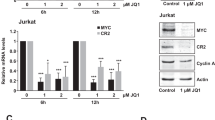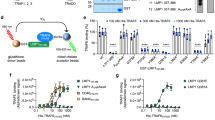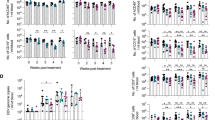Abstract
Despite the identification of Epstein–Barr virus (EBV) in tumors of Burkitt's lymphoma (BL) over 40 years ago, the exact contribution of EBV to BL is undefined. EBV encodes for multiple proteins in latent B cells that affect B cell survival and activation. One such protein, latent membrane protein 2A (LMP2A), protects B cells from numerous pro-apoptotic stimuli. Therefore, we tested whether LMP2A protects B cells from apoptosis induced by aberrant c-MYC expression that precedes and dominates BL. We crossed LMP2A-transgenic mice (LMP2A-Tg), in which all B cells express LMP2A, to a transgenic mouse that expresses a BL translocation of myc (λ-MYC-Tg mice). LMP2A promotes proliferation and protects B cells from MYC-induced apoptosis in λ-MYC-Tg mice. LMP2A also accelerates the development of lymphoma in LMP2A/λ-MYC-Tg mice. Finally, LMP2A increases the expression of Bcl-XL in both pre-tumor B cells and tumor cells, suggesting a mechanism for LMP2A-mediated B cell survival in the presence of MYC. These results support a hypothesis that EBV LMP2A promotes tumor development by protecting pre-tumor B cells that would normally apoptose after the c-myc translocation.
This is a preview of subscription content, access via your institution
Access options
Subscribe to this journal
Receive 50 print issues and online access
$259.00 per year
only $5.18 per issue
Buy this article
- Purchase on Springer Link
- Instant access to full article PDF
Prices may be subject to local taxes which are calculated during checkout



Similar content being viewed by others
References
Anderson LJ, Longnecker R . (2008). EBV LMP2A provides a surrogate pre-B cell receptor signal through constitutive activation of the ERK/MAPK pathway. J Gen Virol 89: 1563–1568.
Babcock GJ, Hochberg D, Thorley-Lawson AD . (2000). The expression pattern of Epstein–Barr virus latent genes in vivo is dependent upon the differentiation stage of the infected B cell. Immunity 13: 497–506.
Bell AI, Groves K, Kelly GL, Croom-Carter D, Hui E, Chan AT et al. (2006). Analysis of Epstein–Barr virus latent gene expression in endemic Burkitt's lymphoma and nasopharyngeal carcinoma tumour cells by using quantitative real-time PCR assays. J Gen Virol 87: 2885–2890.
Caldwell RG, Wilson JB, Anderson SJ, Longnecker R . (1998). Epstein–Barr virus LMP2A drives B cell development and survival in the absence of normal B cell receptor signals. Immunity 9: 405–411.
Chen SY, Lu J, Shih YC, Tsai CH . (2002). Epstein–Barr virus latent membrane protein 2A regulates c-Jun protein through extracellular signal-regulated kinase. J Virol 76: 9556–9561.
Dalla-Favera R, Bregni M, Erikson J, Patterson D, Gallo RC, Croce CM . (1982). Human c-myc onc gene is located on the region of chromosome 8 that is translocated in Burkitt lymphoma cells. Proc Natl Acad Sci USA 79: 7824–7827.
Egle A, Harris AW, Bouillet P, Cory S . (2004). Bim is a suppressor of Myc-induced mouse B cell leukemia. Proc Natl Acad Sci USA 101: 6164–6169.
Eischen CM, Woo D, Roussel MF, Cleveland JL . (2001). Apoptosis triggered by Myc-induced suppression of Bcl-X(L) or Bcl-2 is bypassed during lymphomagenesis. Mol Cell Biol 21: 5063–5070.
Epstein MA, Achong BG, Barr YM . (1964). Virus particles in cultured lymphoblasts from Burkitt's lymphoma. Lancet 1: 702–703.
Fukuda M, Longnecker R . (2004). Latent membrane protein 2A inhibits transforming growth factor-beta 1-induced apoptosis through the phosphatidylinositol 3-kinase/Akt pathway. J Virol 78: 1697–1705.
Garrison SP, Jeffers JR, Yang C, Nilsson JA, Hall MA, Rehg JE et al. (2008). Selection against PUMA gene expression in Myc-driven B-cell lymphomagenesis. Mol Cell Biol 28: 5391–5402.
Gerbitz A, Mautner J, Geltinger C, Hortnagel K, Christoph B, Asenbauer H et al. (1999). Deregulation of the proto-oncogene c-myc through t(8;22) translocation in Burkitt's lymphoma. Oncogene 18: 1745–1753.
Harris AW, Pinkert CA, Crawford M, Langdon WY, Brinster RL, Adams JM . (1988). The E mu-myc transgenic mouse. A model for high-incidence spontaneous lymphoma and leukemia of early B cells. J Exp Med 167: 353–371.
Hemann MT, Bric A, Teruya-Feldstein J, Herbst A, Nilsson JA, Cordon-Cardo C et al. (2005). Evasion of the p53 tumour surveillance network by tumour-derived MYC mutants. Nature 436: 807–811.
Hsu JL, Glaser SL . (2000). Epstein–Barr virus-associated malignancies: epidemiologic patterns and etiologic implications. Crit Rev Oncol Hematol 34: 27–53.
Ikeda A, Merchant M, Lev L, Longnecker R, Ikeda M . (2004). Latent membrane protein 2A, a viral B cell receptor homologue, induces CD5+ B-1 cell development. J Immunol 172: 5329–5337.
Kim JS, Han SS, Park SS, McNeil N, Janz S . (2006). Plasma cell tumour progression in iMycEmu gene-insertion mice. J Pathol 209: 44–55.
Kovalchuk AL, Qi CF, Torrey TA, Taddesse-Heath L, Feigenbaum L, Park SS et al. (2000). Burkitt lymphoma in the mouse. J Exp Med 192: 1183–1190.
Kurth J, Spieker T, Wustrow J, Strickler GJ, Hansmann LM, Rajewsky K et al. (2000). EBV-infected B cells in infectious mononucleosis: viral strategies for spreading in the B cell compartment and establishing latency. Immunity 13: 485–495.
Linden M, Kirchhof N, Carlson C, Van Ness B . (2004). Targeted overexpression of Bcl-XL in B-lymphoid cells results in lymphoproliferative disease and plasma cell malignancies. Blood 103: 2779–2786.
Mancao C, Altmann M, Jungnickel B, Hammerschmidt W . (2005). Rescue of ‘crippled’ germinal center B cells from apoptosis by Epstein–Barr virus. Blood 106: 4339–4344.
Mancao C, Hammerschmidt W . (2007). Epstein–Barr virus latent membrane protein 2A is a B-cell receptor mimic and essential for B-cell survival. Blood 110: 3715–3721.
Newman SC . (2003). Biostatistical Methods in Epidemiology. John Wiley and Sons Inc.: New York, NY.
Nilsson JA, Cleveland JL . (2003). Myc pathways provoking cell suicide and cancer. Oncogene 22: 9007–9021.
Pan YR, Vatsyayan J, Chang YS, Chang HY . (2008). Epstein–Barr virus latent membrane protein 2A upregulates UDP-glucose dehydrogenase gene expression via ERK and PI3K/Akt pathway. Cell Microbiol 10: 2447–2460.
Panousis CG, Rowe DT . (1997). Epstein–Barr virus latent membrane protein 2 associates with and is a substrate for mitogen-activated protein kinase. J Virol 71: 4752–4760.
Park SS, Kim JS, Tessarollo L, Owens JD, Peng L, Han SS et al. (2005). Insertion of c-Myc into IgH induces B-cell and plasma-cell neoplasms in mice. Cancer Res 65: 1306–1315.
Portis T, Longnecker R . (2004). Epstein–Barr virus (EBV) LMP2A mediates B-lymphocyte survival through constitutive activation of the Ras/PI3K/AKT pathway. Oncogene 23: 8619–8628.
Rickinson ABaEK . (2007). Epstein–Barr Virus. Lippincott-Raven Publishers II: Philadelphia, PA.
Swanson PJ, Kuslak SL, Fang W, Tze L, Gaffney P, Selby S et al. (2004). Fatal acute lymphoblastic leukemia in mice transgenic for B cell-restricted bcl-xL and c-myc. J Immunol 172: 6684–6691.
Swanson-Mungerson M, Bultema R, Longnecker R . (2006). Epstein–Barr virus LMP2A enhances B-cell responses in vivo and in vitro. J Virol 80: 6764–6770.
Swanson-Mungerson MA, Caldwell RG, Bultema R, Longnecker R . (2005). Epstein–Barr virus LMP2A alters in vivo and in vitro models of B-cell anergy, but not deletion, in response to autoantigen. J Virol 79: 7355–7362.
Tao Q, Robertson KD, Manns A, Hildesheim A, Ambinder RF . (1998). Epstein–Barr virus (EBV) in endemic Burkitt's lymphoma: molecular analysis of primary tumor tissue. Blood 91: 1373–1381.
Taub R, Kirsch I, Morton C, Lenoir G, Swan D, Tronick S et al. (1982). Translocation of the c-myc gene into the immunoglobulin heavy chain locus in human Burkitt lymphoma and murine plasmacytoma cells. Proc Natl Acad Sci USA 79: 7837–7841.
Thorley-Lawson DA, Gross A . (2004). Persistence of the Epstein–Barr virus and the origins of associated lymphomas. N Engl J Med 350: 1328–1337.
Vervoorts J, Luscher-Firzlaff J, Luscher B . (2006). The ins and outs of MYC regulation by posttranslational mechanisms. J Biol Chem 281: 34725–34729.
Wang H, Nicholas MW, Conway KL, Sen P, Diz R, Tisch RM et al. (2006). EBV latent membrane protein 2A induces autoreactive B cell activation and TLR hypersensitivity. J Immunol 177: 2793–2802.
Youle RJ, Strasser A . (2008). The BCL-2 protein family: opposing activities that mediate cell death. Nat Rev Mol Cell Biol 9: 47–59.
Zhu D, Qi CF, Morse III HC, Janz S, Stevenson FK . (2005). Deregulated expression of the Myc cellular oncogene drives development of mouse ‘Burkitt-like’ lymphomas from naive B cells. Blood 105: 2135–2137.
Acknowledgements
RL is a John Edward Porter Professor in Biomedical Research and supported by the Public Health Service Grants CA62234 and CA73507 from the NCI. The authors thank Dr Herbert C Morse III, the NIAID, and the NCI for the λ-MYC transgenic mice.
Author information
Authors and Affiliations
Corresponding author
Rights and permissions
About this article
Cite this article
Bultema, R., Longnecker, R. & Swanson-Mungerson, M. Epstein–Barr virus LMP2A accelerates MYC-induced lymphomagenesis. Oncogene 28, 1471–1476 (2009). https://doi.org/10.1038/onc.2008.492
Received:
Revised:
Accepted:
Published:
Issue Date:
DOI: https://doi.org/10.1038/onc.2008.492
Keywords
This article is cited by
-
Dasatinib exacerbates splenomegaly of mice inoculated with Epstein-Barr virus-infected lymphoblastoid cell lines
Scientific Reports (2020)
-
EBV-driven B-cell lymphoproliferative disorders: from biology, classification and differential diagnosis to clinical management
Experimental & Molecular Medicine (2015)
-
Epstein–Barr virus latent genes
Experimental & Molecular Medicine (2015)
-
EBV-Related Lymphomas: New Approaches to Treatment
Current Treatment Options in Oncology (2013)
-
Epstein-Barr virus latent membrane protein-2A-induced ΔNp63α expression is associated with impaired epithelial-cell differentiation
Oncogene (2010)



